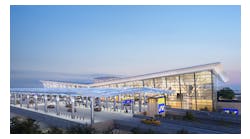What’s Raising the Bar in Airport Lounge Operations?
Airport lounge demand continues to rise around the world. During 2023, we saw over six million guests welcomed in the lounges we operate with our partners, an increase of 35% on the previous year.
This rising demand is running parallel with a shift in passenger expectations, as they increasingly appreciate the amenities and experiences lounges can offer, and airports recognise their commercial role.
International travel has come roaring back following Covid. In January, IATA reported that total revenue passenger km rose 36.9% in 2023 compared to the previous year, edging closer to pre-pandemic levels.
With the globalisation of business and a rise in disposable income, more people are flying. This means airports are getting busier, and travellers of all types are seeking ways to make their journeys more comfortable and enjoyable.
Airport lounges offer a refuge from the hustle and bustle of terminals, providing calm, comfortable and connected spaces. With the advent of social media and travel websites, travellers are also becoming more aware of these benefits.
There’s a consistent flow of new locations opening and existing lounges being upgraded to attract more visitors. Many now offer gourmet food, spa services, sleep pods, shower facilities and entertainment options, making them more appealing to travellers seeking a rewarding experience.
As lounges evolve and experience expectations rise, striking the balance between efficiency, profitability and guest satisfaction is a constant challenge. So what are some of the key factors that have been raising the bar in lounge operations?
Connected Experiences
The rising demand amongst travellers for connectivity at the airport has accelerated since the pandemic. It’s now an expectation for all business and leisure travellers, and particularly younger generations who now represent a larger proportion of travellers.
It’s vital for airports and lounge operators to understand how they can provide an experience that blends the best of physical and digital in the way travellers want.
Today’s tech-savvy traveller expects airport lounge Wi-Fi speed to match the super-fast personal connections enjoyed in their office, hotel or home. They want to smoothly connect to their video call in a quiet space or download their favourite shows in comfort.
From a practical point of view, this means lounge layouts are evolving from a simple divide between formal and informal seating to a much more varied set of options, with pods and private spaces becoming popular, alongside more interesting and atmospheric drinking or dining areas. Managing more varied spaces puts greater demands on the agility of operations and staffing.
Enabling travellers with fast and reliable connectivity in the lounge also presents great opportunities for operators. With the right solutions, they can upsell food, retail and entertainment experiences to travellers through their mobile devices.
It’s these opportunities to digitally connect and engage with passengers that prompted us to develop our e-commerce and passenger loyalty platform called Connecta, which offers lounge visitors a digital experience to keep tabs on their flight status, shop, eat and drink from the comfort of their seat.
Hungry for Innovation
Traditionally, bars and food serving areas have been the centrepiece for many lounges. Building and operating a lounge around this central feature offers advantages because it can create a specific look and feel, without necessarily requiring increased space.
But lounge food and beverage expectations are rapidly evolving, as travellers have more access to interesting drinking or dining experiences elsewhere in the airport terminal.
The food and beverage offering of a lounge is often the biggest factor dictating back of house operations, typically taking up to 30% of the overall space in lounges. Recognising the rising demands of travellers presenting a commercial opportunity, there is now an upselling element to the food and beverage experience in many lounges, with more premium options coming at additional cost.
Travellers are also becoming increasingly conscious around healthy eating and showing interest in smaller plates of more diverse foods. This is beginning to shift the operational emphasis away from larger kitchens serving an a la carte menu. It’s possible to be smarter in how travellers’ desires are met with different equipment set-ups, innovative menus and the support of suppliers.
The latest Airport Experience research by Airport Dimensions highlighted how exclusive and private dining experiences signified the highest discretionary spend for travellers. Evidently, by meeting travellers’ altering food and beverage expectations, and ensuring behind-front-of-house operations remain agile, airports can bolster revenues whilst reducing overheads- ensuring the continuation of their recovery following Covid-19.
Capacity Challenges
With demand rising, and space in many locations limited, queue management is becoming an increasingly important part of effective lounge operations. This involves implementing strategies to optimise the efficiency of queues, minimise wait times and improve the overall passenger experience.
Airport Dimensions has taken inspiration from across the hospitality sector, exploring examples of best practice and technology innovation for solutions. From digital menus and contactless ordering to advanced point of sale systems, technology is streamlining processes and overall experiences. Utilising mobile app enabled systems allows for effective capacity management and ensures a better traveller experience.
The benefits are threefold. First, they help to ensure lounges don’t get too overcrowded or undermine the experience of travellers already present, or impact on operations by creating too much pressure on staff. Secondly, they help to engage and keep those travellers who face a wait feeling that their time and interests are being looked after in the right way.
Finally, they create more revenue opportunities for airports, because travellers can use their wait time productively to shop or seek out other experiences, safe in the knowledge that they will be called when space becomes available and there's going to be a seat reserved.
Time Better Spent
Airport lounges provide travellers with amenities that give them greater choice over how they spend their time prior to boarding their flight.
For some travellers, paying for lounge access as part of their trip enhances their overall experience. The latest Airport Experience research study found that over half of travellers surveyed across the world who took two or more trips within 12 months (52%) visited a lounge at some time during their travels.
What’s more, the research highlighted the increased desire for younger travellers, in particular, to spend on new services and experiences such as sleep suites (11% of discretionary spend), gaming (5%) and wellness and grooming (9%). This goes hand in hand with the movement towards lounge users placing a growing emphasis on a leisure-oriented experience rather than business productivity. Indeed, business facilities being available in lounges now ranks as the lowest motivator for purchase intent. While just under half (49%) said they chose to purchase lounge access for the business facilities, 79% go for the food and 62% visit to enjoy the leisure amenities.
This reflects the importance for airport lounges to go beyond simply meeting the expectations of travellers, but incorporating experiential services that enhance experience and drive new revenue.
By leveraging industry relationships and knowledge, airports can deliver customer satisfaction and operate commercially successful lounges for their partners.



